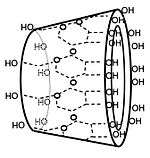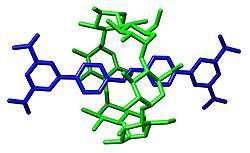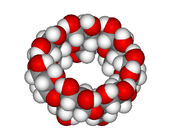Cyclodextrin
Cyclodextrins (sometimes called cycloamyloses) are a family of compounds made up of sugar molecules bound together in a ring (cyclic oligosaccharides).
Cyclodextrins are produced from starch by means of enzymatic conversion. They are used in food, pharmaceutical,[1] drug delivery,[2] and chemical industries, as well as agriculture and environmental engineering.
Cyclodextrins are composed of 5 or more α-D-glucopyranoside units linked 1->4, as in amylose (a fragment of starch). The 5-membered macrocycle is not natural. Recently, the largest well-characterized cyclodextrin contains 32 1,4-anhydroglucopyranoside units, while as a poorly characterized mixture, at least 150-membered cyclic oligosaccharides are also known. Typical cyclodextrins contain a number of glucose monomers ranging from six to eight units in a ring, creating a cone shape:
- α (alpha)-cyclodextrin: 6-membered sugar ring molecule
- β (beta)-cyclodextrin: 7-membered sugar ring molecule
- γ (gamma)-cyclodextrin: 8-membered sugar ring molecule
α- and γ-cyclodextrin are being used in the food industry. As α-cyclodextrin is a soluble dietary fiber, it can be found as Alpha Cyclodextrin (soluble fiber) on the list of ingredients of commercial products.

Applications
Increasing bioavailability
Because cyclodextrins are hydrophobic inside and hydrophilic outside, they can form complexes with hydrophobic compounds. Thus they can enhance the solubility and bioavailability of such compounds. This is of high interest for pharmaceutical as well as dietary supplement applications in which hydrophobic compounds shall be delivered. Alpha-, beta-, and gamma-cyclodextrin are all generally recognized as safe by the FDA.[3][4][5]
Cholesterol free products
In the food industry, cyclodextrins are employed for the preparation of cholesterol free products: the bulky and hydrophobic cholesterol molecule is easily lodged inside cyclodextrin rings that are then removed.
Multifunctional dietary fiber
α-Cyclodextrin has been authorized for use as a dietary fiber in the European Union since 2008.[6] In 2013 the EU commission has verified a health claim for alpha-cyclodextrin. The EU assessment report confirms that consumption of alpha-cyclodextrin can reduce blood sugar peaks following a high-starch meal.[7] Weight loss supplements are marketed from alpha-cyclodextrin which claim to bind to fat and be an alternative to other anti-obesity medications.[8][9]
Due to its surface-active properties, α-cyclodextrin can also be used as emulsifying fiber, for example, in mayonnaise as well as a whipping aid, for example, in desserts and confectionery applications.
Other food applications
Applications further include the ability to stabilize volatile or unstable compounds and the reduction of unwanted tastes and odour. Beta-cyclodextrin complexes with certain carotenoid food colorants have been shown to intensify color, increase water solubility and improve light stability.[10][11]
The strong ability of complexing fragrances can also be used for another purpose: first dry, solid cyclodextrin microparticles are exposed to a controlled contact with fumes of active compounds, then they are added to fabric or paper products. Such devices are capable of releasing fragrances during ironing or when heated by human body. Such a device commonly used is a typical 'dryer sheet'. The heat from a clothes dryer releases the fragrance into the clothing.
Cyclodextrins are also used to produce alcohol powder by encapsulating ethanol. The powder produces an alcoholic beverage when mixed with water.
Aerosols
Aqueous cyclodextrin solutions can generate aerosols in particle size ranges suitable for pulmonary deposition. Large quantities of aerosol can be nebulized in acceptable nebulization times. The cyclodextrin concentration does not modify nebulization efficiency in the range tested.[12]
Clinical
In April 2009, compassionate use investigational new drug (IND) applications were filed by Benioff Children's Hospital Oakland and Mr. Hugh and Chris Hempel, parents of Addison and Cassidy Hempel, identical twin girls suffering from Niemann-Pick disease, type C. This was the second time in history that cyclodextrin alone was proposed to treat a fatal disease. In 1987, cyclodextrin was used in a medical case involving a boy suffering from a fatal form of hypervitaminosis A.
On January 23, 2013, a formal clinical trial to evaluate HPβCD cyclodextrin therapy as a treatment for Niemann-Pick disease, type C was announced by scientists from the NIH’s National Center for Advancing Translational Sciences (NCATS) and the Eunice Kennedy Shriver National Institute of Child Health and Human Development (NICHD). A Phase I clinical trial is currently being conducted at the NIH Clinical Center.
Structure

Typical cyclodextrins are constituted by 6-8 glucopyranoside units, can be topologically represented as toroids with the larger and the smaller openings of the toroid exposing to the solvent secondary and primary hydroxyl groups respectively. Because of this arrangement, the interior of the toroids is not hydrophobic, but considerably less hydrophilic than the aqueous environment and thus able to host other hydrophobic molecules. In contrast, the exterior is sufficiently hydrophilic to impart cyclodextrins (or their complexes) water solubility.
The formation of the inclusion compounds greatly modifies the physical and chemical properties of the guest molecule, mostly in terms of water solubility. This is the reason why cyclodextrins have attracted much interest in many fields, especially pharmaceutical applications: because inclusion compounds of cyclodextrins with hydrophobic molecules are able to penetrate body tissues, these can be used to release biologically active compounds under specific conditions.[13] In most cases the mechanism of controlled degradation of such complexes is based on pH change of water solutions, leading to the loss of hydrogen or ionic bonds between the host and the guest molecules. Alternative means for the disruption of the complexes take advantage of heating or action of enzymes able to cleave α-1,4 linkages between glucose monomers.
Synthesis
The production of cyclodextrins is relatively simple and involves treatment of ordinary starch with a set of easily available enzymes.[14] Commonly cyclodextrin glycosyltransferase (CGTase) is employed along with α-amylase. First starch is liquified either by heat treatment or using α-amylase, then CGTase is added for the enzymatic conversion. CGTases can synthesize all forms of cyclodextrins, thus the product of the conversion results in a mixture of the three main types of cyclic molecules, in ratios that are strictly dependent on the enzyme used: each CGTase has its own characteristic α:β:γ synthesis ratio. Purification of the three types of cyclodextrins takes advantage of the different water solubility of the molecules: β-CD which is very poorly water-soluble (18.5 g/l or 16.3mM) (at 25C) can be easily retrieved through crystallization while the more soluble α- and γ-CDs (145 and 232 g/l respectively) are usually purified by means of expensive and time consuming chromatography techniques. As an alternative a "complexing agent" can be added during the enzymatic conversion step: such agents (usually organic solvents like toluene, acetone or ethanol) form a complex with the desired cyclodextrin which subsequently precipitates. The complex formation drives the conversion of starch towards the synthesis of the precipitated cyclodextrin, thus enriching its content in the final mixture of products. Wacker Chemie AG uses dedicated enzymes, that can produce alpha-, beta- or gamma-cyclodextrin specifically. This is very valuable especially for the food industry, as only alpha- and gamma-cyclodextrin can be consumed without a daily intake limit.
Uses

Cyclodextrins are able to form host-guest complexes with hydrophobic molecules given the unique nature imparted by their structure.[16] As a result, these molecules have found a number of applications in a wide range of fields.
Cyclodextrins can solubilize hydrophobic drugs in pharmaceutical applications, and crosslink to form polymers used for drug delivery.[2][17] One example is Sugammadex, a modified γ-cyclodextrin which reverses neuromuscular blockade by binding the drug rocuronium. Other than the above-mentioned pharmaceutical applications, cyclodextrins can be employed in environmental protection: these molecules can effectively immobilise inside their rings toxic compounds, like trichloroethane or heavy metals, or can form complexes with stable substances, like trichlorfon (an organophosphorus insecticide) or sewage sludge, enhancing their decomposition.
This ability of forming complexes with hydrophobic molecules has led to their usage in supramolecular chemistry. In particular they have been used to synthesize certain mechanically interlocked molecular architectures, such as rotaxanes and catenanes, by reacting the ends of the threaded guest. The photodimerization of substituted stilbazoles has been demonstrated using g-cyclodextrin as a host . Based on the photodimer obtained, it is established that the halogen-halogen interactions, which play an interesting role in solid state, can be observed in solution. Existence of such interactions in solution has been proved by selective photodimerization of dichloro substituted stiblazoles in Cyclodextrin and Cucurbiturils.[18]
The application of cyclodextrin as supramolecular carrier is also possible in organometallic reactions. The mechanism of action probably takes place in the interfacial region.[19] Wipff also demonstrated by computational study that the reaction occurs in the interfacial layer. The application of cyclodextrins as supramolecular carrier is possible in various organometallic catalysis.
In 2013, α-cyclodextrin is found to be able to selectively form second-sphere coordination complex with tetrabromoaurate anion ([AuBr4]-) from transition-metal anion mixtures, and thus is used to selectively recover gold from various gold-bearing materials in an environmentally benign manner.[20]
β-cyclodextrins are used to produce HPLC columns allowing chiral enantiomers separation,[21] and are also the main ingredient in P&G's product Febreze which claims that the β-cyclodextrins "trap" odor causing compounds, thereby reducing the odor.[22]
Derivatives
Methyl-β-cyclodextrin
Both β-cyclodextrin and methyl-β-cyclodextrin (MβCD) remove cholesterol from cultured cells. The methylated form MβCD was found to be more efficient than β-cyclodextrin. The water-soluble MβCD is known to form soluble inclusion complexes with cholesterol, thereby enhancing its solubility in aqueous solution. MβCD is employed for the preparation of cholesterol-free products: the bulky and hydrophobic cholesterol molecule is easily lodged inside cyclodextrin rings that are then removed. MβCD is also employed in research to disrupt lipid rafts by removing cholesterol from membranes.[23]
History

Cyclodextrins, as they are known today, were called "cellulosine" when first described by A. Villiers in 1891.[24] Soon after, F. Schardinger identified the three naturally occurring cyclodextrins -α, -β, and -γ. These compounds were therefore referred to as "Schardinger sugars". For 25 years, between 1911 and 1935, Pringsheim in Germany was the leading researcher in this area, demonstrating that cyclodextrins formed stable aqueous complexes with many other chemicals. By the mid-1970s, each of the natural cyclodextrins had been structurally and chemically characterized and many more complexes had been studied. Since the 1970s, extensive work has been conducted by Szejtli and others exploring encapsulation by cyclodextrins and their derivatives for industrial and pharmacologic applications.[25] Among the processes used for complexation, the kneading process seems to be one of the best.[26]
References
- ↑ Menuel, Stéphane; Joly, Jean-Pierre; Courcot, Blandine; Elysée, Josias; Ghermani, Nour-Eddine; Marsura, Alain (2007). "Synthesis and inclusion ability of a bis-β-cyclodextrin pseudo-cryptand towards Busulfan anticancer agent". Tetrahedron. 63 (7): 1706. doi:10.1016/j.tet.2006.10.070.
- 1 2 Thatiparti, Thimma R.; Shoffstall, Andrew J.; Von Recum, Horst A. (2010). "Cyclodextrin-based device coatings for affinity-based release of antibiotics". Biomaterials. 31 (8): 2335–47. doi:10.1016/j.biomaterials.2009.11.087. PMID 20022369.
- ↑ GRAS Notice No. GRN 000155, alpha-cyclodextrin
- ↑ GRAS Notice No. GRN 000074, beta-cyclodextrin
- ↑ GRAS Notice No. GRN 000046, gamma-cyclodextrin
- ↑ COMMISSION DECISION of 26 May 2008 authorising the placing on the market of alpha-cyclodextrin as a novel food ingredient under Regulation (EC) No 258/97 of the European Parliament and of the Council
- ↑ EFSA panel on dietetic Products Nutrition and Allergies (2012-06-05). "Scientific Opinion on the substantiation of health claims related to alpha-cyclodextrin and reduction of post-prandial glycaemic responses (ID 2926, further assessment) pursuant to Article 13(1) of Regulation (EC) No 1924/2006". The EFSA Journal. 10 (6): 2713. doi:10.2903/j.efsa.2012.2713. ISSN 1831-4732. Retrieved 2016-04-13.
- ↑ Artiss, Joseph D.; Brogan, Kathryn; Brucal, Michelle; Moghaddam, Marjan; Jen, K.-L. Catherine (2006). "The effects of a new soluble dietary fiber on weight gain and selected blood parameters in rats". Metabolism. 55 (2): 195–202. doi:10.1016/j.metabol.2005.08.012. PMID 16423626.
- ↑ Grunberger, George; Jen, K-L Catherine; Artiss, Joseph D. (2007). "The benefits of early intervention in obese diabetic patients with FBCx™ — a new dietary fibre". Diabetes/Metabolism Research and Reviews. 23 (1): 56–62. doi:10.1002/dmrr.687. PMID 17013969.
- ↑ Marcolino, Vanessa Aparecida; Zanin, Gisella Maria; Durrant, Lucia Regina; Benassi, Marta De Toledo; Matioli, Graciette (2011). "Interaction of Curcumin and Bixin with β-Cyclodextrin: Complexation Methods, Stability, and Applications in Food". Journal of Agricultural and Food Chemistry. 59 (7): 3348–57. doi:10.1021/jf104223k. PMID 21381747.
- ↑ De Oliveira, Vanessa E.; Almeida, Eduardo W. C.; Castro, Harlem V.; Edwards, Howell G. M.; Dos Santos, Hélio F.; De Oliveira, Luiz Fernando C. (2011). "Carotenoids and β-Cyclodextrin Inclusion Complexes: Raman Spectroscopy and Theoretical Investigation". The Journal of Physical Chemistry A. 115 (30): 8511–9. doi:10.1021/jp2028142. PMID 21728366.
- ↑ Le, VN; Leterme, P; Gayot, A; Flament, MP (2006). "Aerosolization potential of cyclodextrins--influence of the operating conditions". PDA journal of pharmaceutical science and technology. 60 (5): 314–22. PMID 17089700.
- ↑ Becket, Gordon; Schep, Leo J.; Tan, Mun Yee (1999). "Improvement of the in vitro dissolution of praziquantel by complexation with α-, β- and γ-cyclodextrins". International Journal of Pharmaceutics. 179 (1): 65–71. doi:10.1016/S0378-5173(98)00382-2. PMID 10053203.
- ↑ Biwer, A.; Antranikian, G.; Heinzle, E. (2002). "Enzymatic production of cyclodextrins". Applied Microbiology and Biotechnology. 59 (6): 609–17. doi:10.1007/s00253-002-1057-x. PMID 12226716.
- ↑ Stanier, Carol A.; o’Connell, Michael J.; Anderson, Harry L.; Clegg, William (2001). "Synthesis of fluorescent stilbene and tolan rotaxanes by Suzuki coupling". Chemical Communications (5): 493. doi:10.1039/b010015n.
- ↑ Brocos, Pilar; DíAz-Vergara, Norma; Banquy, Xavier; PéRez-Casas, Silvia; Costas, Miguel; PiñEiro, ÁNgel (2010). "Similarities and Differences Between Cyclodextrin−Sodium Dodecyl Sulfate Host−Guest Complexes of Different Stoichiometries: Molecular Dynamics Simulations at Several Temperatures". The Journal of Physical Chemistry B. 114 (39): 12455–67. doi:10.1021/jp103223u. PMID 20836518.
- ↑ Barreto, Lívia; Cunha Filho, Marcílio (2008). "Cyclodextrin: important pharmaceutical functional excipient". Latin American Journal of Pharmacy. 27 (4): 629–636. Retrieved 24 April 2014.
- ↑ Kaliappan, Raja; Maddipatla, Murthy V. S. N.; Kaanumalle, Lakshmi S.; Ramamurthy, V. (2007). "Crystal engineering principles applied to solution photochemistry: Controlling the photodimerization of stilbazolium salts within ?-cyclodextrin and cucurbit\8]uril in water". Photochemical & Photobiological Sciences. 6 (7): 737. doi:10.1039/B704817C.
- ↑ Leclercq, Loïc; Bricout, Hervé; Tilloy, Sébastien; Monflier, Eric (2007). "Biphasic aqueous organometallic catalysis promoted by cyclodextrins: Can surface tension measurements explain the efficiency of chemically modified cyclodextrins?". Journal of Colloid and Interface Science. 307 (2): 481–7. doi:10.1016/j.jcis.2006.12.001. PMID 17188284.
- ↑ Liu, Zhichang; Frasconi, Marco; Lei, Juying; Brown, Zachary J.; Zhu, Zhixue; Cao, Dennis; Iehl, Julien; Liu, Guoliang; Fahrenbach, Albert C.; Botros, Youssry Y.; Farha, Omar K.; Hupp, Joseph T.; Mirkin, Chad A.; Stoddart, J. Fraser (2013). "Selective isolation of gold facilitated by second-sphere coordination with α-cyclodextrin". Nature Communications. 4: 1855. doi:10.1038/ncomms2891. PMID 23673640.
- ↑ Motoyama, Akira; Suzuki, Ayako; Shirota, Osamu; Namba, Ryujiro (2002). "Direct determination of pindolol enantiomers in human serum by column-switching LC-MS/MS using a phenylcarbamate-β-cyclodextrin chiral column". Journal of Pharmaceutical and Biomedical Analysis. 28 (1): 97–106. doi:10.1016/S0731-7085(01)00631-8. PMID 11861113.
- ↑ http://chemistry.about.com/od/cleanerchemistry/f/how-febreze-works.htm
- ↑ Rodal, Siv Kjersti; Skretting, Grethe; Garred, Øystein; Vilhardt, Frederik; van Deurs, Bo; Sandvig, Kirsten (1999). "Extraction of Cholesterol with Methyl-β-Cyclodextrin Perturbs Formation of Clathrin-coated Endocytic Vesicles". Molecular Biology of the Cell. 10 (4): 961–74. doi:10.1091/mbc.10.4.961. PMC 25220
 . PMID 10198050.
. PMID 10198050. - ↑ Villiers A., Sur la transformation de la fécule en dextrine par le ferment butyrique, Compt. Rend. Fr. Acad. Sci. 1891:435-8
- ↑ Szejtli J. (1988). "Cyclodextrin Technology" vol 1. Springer, New York" ISBN 978-90-277-2314-7
- ↑ Gil, A.; Chamayou, A.; Leverd, E.; Bougaret, J.; Baron, M.; Couarraze, G. (2004). "Evolution of the interaction of a new chemical entity, eflucimibe, with γ-cyclodextrin during kneading process". European Journal of Pharmaceutical Sciences. 23 (2): 123–9. doi:10.1016/j.ejps.2004.06.002. PMID 15451000.
External links
- Cyclodextrin Database
- Addi and Cassi Hempel, identical twins with Niemann Pick Type C being treated with HPßCD cyclodextrin
- Information on Cyclodextrin, HIV/AIDS and Niemann Pick Type C
- OpenCDLig: a free Web application for host/guest complexes
- The European Cyclodextrin Society
- "Sweet drug clears cholesterol, reverses heart disease—and was found by parents"
- Ritter, Helmut (2012). "Superstructures with cyclodextrins: Chemistry and applications". Beilstein Journal of Organic Chemistry. 8: 1303–4. doi:10.3762/bjoc.8.148. PMC 3458753
 . PMID 23019463.
. PMID 23019463. - Shityakov, Sergey; Broscheit, Jens; Förster, Carola (2012). "α-Cyclodextrin dimer complexes of dopamine and levodopa derivatives to assess drug delivery to the central nervous system: ADME and molecular docking studies". International Journal of Nanomedicine. 7: 3211–3219. doi:10.2147/IJN.S31373. PMC 3394464
 . PMID 22811606.
. PMID 22811606.